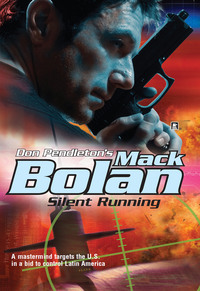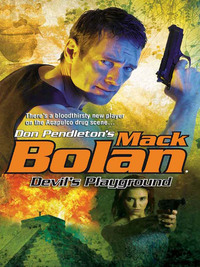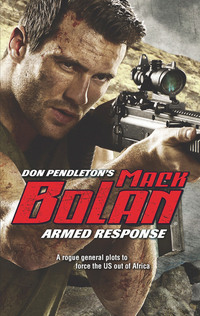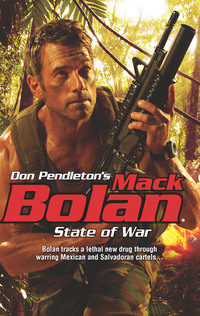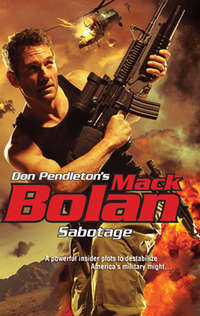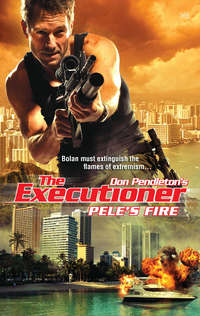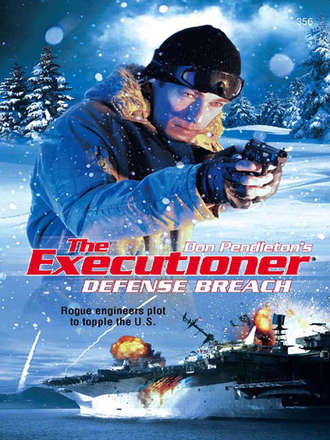
Полная версия
Defense Breach
“Police!” he shouted to alert whomever might be under the floorboards. He had told lies much worse than impersonating an officer of the law. “Come out with your hands up.”
There was no response.
Bolan placed the penlight between his teeth and drew his knife, sliding the blade into the crack forming one of the short sides. Using the weapon as a lever, he discovered there was no locking mechanism on the door. With minimal effort he was able to pry it open a few inches, which then grew wider as he pushed down on the knife’s leather grip. When there was sufficient space between the door and the floor, he grabbed the hatch’s edge with the hand holding his Beretta and threw it back all the way. The door banged open onto the floorboards, sounding unnaturally loud in the still of the bedroom.
“Please! Please don’t kill me,” came from the darkness below. The words were spoken in a voice laced with terror.
Bolan had been exposed to people on the brink of hysteria innumerable times throughout his career, and it was never a situation he preferred. Survival in his line of work was often dependent on controlling more variables than his opponent, and people scared out of their wits were not easy to control. He turned sideways to reduce his profile and held the penlight away from his body as he shone the beam into the void.
A woman was huddled in the far corner, her eyes blinking in rapid response to the light.
“Please,” she said in a vacant voice.
“I won’t hurt you,” Bolan replied, holstering his Beretta upon seeing she was alone and unarmed.
“I thought you were one of them. They’re coming back,” she stated.
The dugout was about four feet deep and tiny, cramped by a single electronics cabinet that hummed evenly next to a small table supporting a computer monitor. A pair of industrial-gauge wires ran from the cabinet to the monitor, on which Bolan could see six incandescent green blips moving in a tight group.
“Does that tell you how far away they are?” he asked.
Her eyes wandered to the screen where they rested for a moment before she shook her head and repeated vacuously, “They’re coming back.”
“Come on,” the Executioner said.
The woman pushed herself away from the wall and grabbed Bolan’s outstretched hand to boost herself out of the dugout and onto the bedroom floor. As Bolan pulled her to her feet, he gave her an appraising look while slipping the penlight back into its pouch.
She was disheveled and dirty, dressed in jeans and an unzipped maroon ski parka over a gray sweatshirt with San Diego Chargers emblazoned in cursive pink across the front. Bolan guessed she was in her late twenties. The earrings she wore, along with the stylish cut of her jet-black hair, told him she was neither a camper nor a survivalist.
“Don’t look,” Bolan said as he led her out of the bedroom toward the cabin’s door.
“I heard.” Her voice caught in her throat and her knees buckled, causing her to lean in to Bolan. He put his arm around her, supporting her weight until they came to the door. “They kept shooting Davey,” she said. “They kept shooting him, but Wes couldn’t give them what they wanted. I was afraid he was going to tell them where I was hiding. They kept asking if there were three of us.”
“What did they want from Wes?” Bolan asked.
She sniffed once before her eyes began spilling tears as if an inner dam had suddenly given way. “The rest of the code!” she said in a hitching voice that shook her entire body. “Wes only had half. After they left I kept trying to call 911 on my cell phone. I couldn’t get through to…” Her voice tapered off.
“Do you work for Nautech?” Bolan asked.
“We all do.”
“What’s your name?”
She swallowed hard and wiped her tear-streaked cheeks with her palms before replying, “Sherry Krautzer.”
“Okay, Sherry. We’re getting out of here.”
Winter darkness fell quickly in Manitoba. When Bolan pushed the cabin door open, he discovered it was as black as midnight outside. He grabbed Sherry’s hand and started pulling her toward the spot in the woods where his equipment was stashed, realizing before they took half a dozen steps that the snowmobiles he had heard earlier were much closer now.
“Hurry,” he said. “You have to hide in the woods until I take care of them. Understand?”
Her teeth were chattering when she replied, “Marlene said no one would get hurt. But they kept shooting Davey to make Wes tell them. Wes doesn’t know who has the other half. None of us do.”
Bolan jerked her arm roughly, realizing she was going into shock.
“Listen,” he said, pulling her to within inches of his face when they reached the tree line. “If they see you, they’ll kill you. Do you understand me? You have to stay hidden.”
She was nodding when he pushed her to the ground under the canopy of a sprawling pine where she wouldn’t be spotted.
“Don’t move until I come to get you. Understand?”
She nodded again, but the way she kept touching her face with fluttering hands and looking about with vacant eyes did little to reassure Bolan, who understood from experience the unpredictability extreme terror caused.
“Sherry. Do not move until I come get you. They’re coming back to kill you,” he said.
“Okay.” She paused, then repeated, “Okay.”
Bolan left her concealed behind the pine boughs and ran to find a position offering sufficient cover from automatic weapons. Before killing Wes, they had apparently made him watch while they mutilated his friend’s corpse. The fact that they had taken a psychological rather than physical approach to torture was telling. They were either thugs receiving specific instructions from a handler who kept them under tight control, or they were well-trained, intelligent operatives with authority to ad lib. Fanatical terrorists blindly following orders were one thing—skilled professional soldiers dedicated to a greater cause were an entirely different matter. When survival was at stake, Bolan preferred going up against the former.
The snowmobiles appeared in his binoculars as six specks of light when they were still miles from the section where trees grew in shallow stands dotting the open prairie. Sherry said that Davey and Wes were able to give their killers only one-half of the code. Bolan thought amateurs might naively believe they were protected when dealing with terrorist elements by not turning over the complete package until they received full payment. But what an inexperienced person might not understand was a terrorist’s willingness to torture and steal rather than part with money that could be better spent on recruitment, weapons and training. They’d kill everyone involved simply to cover their tracks and eliminate all traces of their transactions. Bolan had witnessed the scenario too many times to count. In a transaction pitting rookies against professionals, the pros always won.
As he watched the approaching snowmobile headlights, he pondered the group’s return. Sherry had tried to make a call on her cell phone, not realizing that out here in the wilderness, the probability of being in range of a communications tower was slim. What she had actually done was send out an electronic ping that announced her presence while it searched for a connection. The killers had to have picked up the transmission on a scanner and realized that the third person they suspected could have been with Davey and Wes was, in fact, in the cabin. They were coming back to finish the job.
They were about to get more than they bargained for, the Executioner thought.
From his position at the base of a thick maple, Bolan reached into the pouch on his web belt containing his night-vision goggles. He focused the goggles, bringing the six pinpoints of light into sharp relief. Magnified hundreds of times as they passed through the internal photocathode tube, the photons from the approaching headlights shone with the intensity of search beacons. Each snowmobile carried a single rider, and it appeared that one vehicle was pulling a sled holding something that resembled a miniature howitzer. From its profile, Bolan was sure the item was a weapon of some type. Its pertinent characteristics, he knew, would soon become known. He drew his Beretta 93-R from its shoulder holster, reached into the pouch holding the handgun’s suppressor and screwed the extension onto the end of the pistol’s barrel. He knew there was going to be gunfire, and figured he should delay announcing his location until absolutely necessary.
The snowmobiles maintained a steady speed, splitting up when they came close. The vehicle pulling the sled with the unknown weapon halted approximately twenty yards from the cabin, while two veered off toward Bolan and the other three set out to circle the structure and cruise along the adjacent tree line from the opposite direction. The precision of their maneuver reinforced Bolan’s earlier consideration that they might be skilled combatants. He remained silent as the pair coming his way passed in front of his position, taking note of their weapons as they passed.
The men were armed with Uzi submachine guns slung across their chests on canvas slings. The fixed wooden stocks were characteristic of the very early versions of the famous weapon, but Bolan knew enough not to assume that the vintage models were anything less than lethal.
Through his night-vision goggles, Bolan studied the man with the sled weapon as he began preparing the contraption. At first glance it appeared to be a stubby cylinder mounted onto a rectangular metal box, but as Bolan continued to observe, he noted that the tube was not hollow, and thick cables ran the entire length of the protrusion. There was a sighting mechanism close to one end, and dual handles similar to those found on antiaircraft guns. The operator fiddled with what had to have been dials or switches on his side of the box before grasping the dual handles and maneuvering the tube. The comparison to an antiaircraft gun was further reinforced with the cylinder being mounted on a free-floating ball pedestal affording the gunner complete three-axis rotation.
The two men who had passed Bolan continued on their slow route circling the cabin. They were halfway between Bolan and Sherry’s hiding place when she abruptly burst from under the pine, hysterically begging them not to kill her. As they hastily grabbed to pull their Uzis into firing position, Bolan’s silenced 93-R coughed twice in such rapid succession the rounds sounded as if they shared a single retort.
The first 9 mm Parabellum round struck the driver of the snowmobile on Bolan’s right, entering the base of his neck on an upward trajectory. The hot lead tore through his skull, exiting from the center of his forehead and splattering most of his frontal lobes onto the machine’s dashboard controls. The tissue immediately froze upon contact with cold metal that had been exposed to frigid air for hours. The man’s throttle hand froze in a death grip, causing his snowmobile to surge forward, accelerating him directly into the side of the building where the machine crashed and revved angrily while the spinning tread underneath chewed and spit out a thin stream of snow for a few seconds before stalling.
His partner fared no better. Bolan’s second bullet slammed a millisecond after the first into the middle of his back, piercing his heart and shattering his sternum on its way out. The gaping chest wound left in the slug’s wake was immediately filled with a scarlet fountain rushing forth in a torrent of steaming blood that painted a thick swath across the ground. He slumped forward, bounced off the steering wheel and fell sideways into the snow. His vehicle came to an abrupt stop a few feet from the lifeless body.
The mind-numbing chatter of automatic fire filled the air as the three who had circled the cabin from the other direction opened fire on Sherry. The 9 mm steel-jacketed rounds sliced diagonally from her left knee to her right shoulder, causing the young woman to jerk and dance wildly. A burst into her upper torso lifted her off her feet and hammered her backward into the woods, where she landed faceup, unseeing eyes staring into the star-studded sky.
Realizing they were under attack, the gunmen immediately shifted their fire away from the dead woman and began hosing the woods with a steady stream of lethal lead. Not being sure of Bolan’s position, they swept their weapons in wide overlapping arcs, reducing branches and saplings to a blizzard of matchsticks that rained down onto their intended victim’s head.
With their wild response telling him that his enemies had not yet zeroed in on his position, Bolan remained prone while pulling the Desert Eagle off his hip.
An electronic humming, so low it sounded almost like an earthquake’s rumbling, emanated from the sled weapon. The operator shouted out a warning to his companions seconds before the hum increased in both intensity and pitch. The entire cabin began to vibrate. Thin tendrils of smoke rose from the weathered siding like surface fog rolling across a body of water, then the cabin abruptly burst into flame. An instant later, the propane tank exploded in a fireball reaching two hundred feet into the sky.
Microwave, Bolan thought, immediately elevating the weapon’s operator to the top of his hit list. Unaware that his cohorts on the other side of the cabin were under attack, the gunner leaned forward over a control panel to make an adjustment, exposing the upper half of his body. With the noise from the crackling fire racing through the wooden structure masking his Desert Eagle’s authoritative discharge, Bolan squeezed off a single round while remaining concealed behind the base of the thick maple. The pistol’s hefty .44-caliber slug caught the microwave gunner square in his chest, tossing him airborne for a few seconds. He bounced once upon hitting the frozen ground, landing on his back with arms extended to the sides.
The Executioner directed his fire toward one of the remaining three who was visible beyond the burning cabin. Pulling the trigger as rapidly as he could, he released a stream of bullets, forcing the gunman within his line of sight to dive off his snowmobile and take cover behind the vehicle. Bolan’s rounds sparked and whined as they impacted the snowmobile’s metal fuselage, adding to the visual and auditory chaos of combat.
Displaying a telling level of advanced training, the gunmen fanned out in an attempt to separate sufficiently to establish a triangular focus on Bolan’s position, which was now fully exposed by the Desert Eagle’s prolonged volley. While the two who were still mounted on snowmobiles moved away, the man on the ground covered their progress with his Uzi on full-auto, filling the air around Bolan with deadly shot.
The warrior had seen the maneuver countless times. If he stayed put, his enemies would flank his position and kill him in a cross fire. He remained low while edging away from the tree trunk, waiting for a break when the gunman would be changing magazines. As if his enemy was enacting his mental script, there was a momentary tapering off in the covering fire, and Bolan seized the opportunity to dash in a crouch into the thin woods to the spot ten yards away where he had stashed his snowmobile. As he ran, he ejected the spent magazine in his Desert Eagle, grabbed into his ammo pouch for a fresh one and rammed it home.
Behind him, the cabin groaned once and collapsed on itself with a heavy sigh resembling a man’s final exhale, becoming a fifteen-foot heap of flickering rubble. Without the building’s hungry flames leaping high into the air, visibility was abruptly and dramatically reduced.
Peering through the trees with his night-vision goggles, Bolan could see his adversary in a prone position behind his snowmobile, the stubby muzzle of his Uzi poking around the vehicle’s front end. The man’s partners had moved far enough away to be outside the halo emitted by the burning cabin, apparently playing the odds that their opponent would not be equipped with night vision. Considering what his course of action would be if the tables were turned, Bolan thought his enemies would take cover in one of the little snow gullies before attempting a flanking movement. He jumped onto his snowmobile, revved the powerful motor, and sped straight toward the gunman who had been attempting to pin him down while his partners maneuvered.
In an effort to reduce his profile as much as possible, Bolan hugged his snowmobile’s fuselage as he shot out of the tree line on a direct course for the man lying in a covered position behind his vehicle. Making sure to maintain a straight-on approach to take advantage of the protection his snowmobile’s windshield offered, Bolan fired the Desert Eagle with his left hand, holding the snowmobile’s handlebars steady with his right.
The move obviously surprised his opponent, who hesitated for a fatal second before engaging the fast-approaching warrior with his Uzi, filling the night air with the chilling sound of automatic chatter. The 9 mm lead sprayed wildly across the space separating Bolan from his enemy. Bullets ricocheted off his bulletproof windshield as he charged forward at full throttle, covering the distance between him and his foe in less than thirty seconds. In a move resembling that of a bullfighter, the Executioner swung outward at the last instant in order to avoid a collision, his Desert Eagle roaring death in triple-time tempo. A few rounds sparked upon impact with the gunman’s Uzi a nanosecond before a pair of .44 rounds whizzing through the air in heel-to-toe configuration found the man’s face, exploding his head in a crimson blossom. Bolan pulled hard on the snowmobile’s handlebars while depressing the brake, causing the machine to slide sideways next to the dead man’s vehicle. Throwing himself to the ground, he rolled into a prone position taking advantage of both snowmobiles for cover.
From his new location, he looked out beyond the pile of smoldering rubble of the cabin. One of his two remaining opponents was crawling toward the microwave cannon, while his partner engaged Bolan with a steady stream of lead from the relative safety of a snow gully approximately fifty feet away. Bolan drew his Beretta and fired the silenced weapon with his right hand while simultaneously blazing away with the Desert Eagle in his left, halting the man’s progress toward the cannon and driving him back into the same gully as his teammate. A series of angry curses told him he had hit, albeit not fatally, the gunner trying to reach the microwave weapon.
With his enemies now occupying positions where they could battle him with only their heads exposed above the lip of the gully, the situation was classic trench warfare. Two adversarial forces separated by a no-man’s land one hundred yards wide, with the microwave cannon occupying a position equidistant from both sides. In this situation, the day would belong to the combatant who could flush the other from cover.
Bolan holstered his Beretta, changed out magazines in the Desert Eagle and, while sporadically firing well-aimed shots to prevent his foes from advancing, reached into one of the pouches on his web belt containing a length of thin cord resembling braided dental floss. The three-hundred-foot length of specialty twine was fine enough to fold entirely in the palm of his hand while possessing all the strength of mountaineering rope.
Remaining behind the fuselage of his late adversary’s snowmobile, Bolan reached up and wrapped a section of the cord around the vehicle’s throttle to provide a steady fuel supply. When he turned the ignition key, the engine sprang to life, purring in neutral while he twisted the handlebars to aim the snowmobile toward the gully holding his foes. With the rounds from his Desert Eagle keeping his opponents pinned, Bolan used his free hand to unhook two concussion grenades from his combat belt’s webbing and set the fuses to their maximum thirty seconds. Throwing the shift into gear, he dropped the apple-shaped bombs into the snowmobile’s two cup holders and released the vehicle.
The snowmobile moved on a perfectly straight course from Bolan to the gully, where it toppled into the depression, carrying its lethal load into the trench occupied by the two gunmen. When the grenades detonated with an eardrum-throbbing concussion, they ignited the vehicle’s gas tank, spraying the fuel through the trench in a firestorm reminiscent of a Vietnam napalm attack. The ferocious explosion left no doubt regarding its effectiveness, but Bolan had his Desert Eagle loaded, cocked and held at the ready when he walked to the edge of the snow gully to investigate the damage. His former adversaries were charred beyond recognition, calling to mind the corpse he had discovered inside the cabin.
The Executioner walked slowly back to his snowmobile, started the engine and drove to the microwave weapon. With a remaining section of the cord, he was able to securely attach the sled to his vehicle before setting off toward the North Dakota border approximately seven hours distant. When he got close to the States, he’d come into range of a telephone tower enabling him to make an encrypted call to Barbara Price, Stony Man Farm’s mission controller. She would take care of the necessary cleanup and the retrieval of remains to be delivered to the families of the Nautech engineers.
The hunting horn had been sounded. There were miles to go before the Executioner would find rest.
2
Ali Ansari Hasseim squinted against the water’s glare as he gazed southwest from the outskirts of Bandar-e Abbas, a biblical town on Iran’s Persian coast across the channel from Qeshm Island. Below him sat the narrow Strait of Hormuz, through which twenty percent of the world’s oil supply passed. The busy waterway was bordered by Iran, Oman’s Musandam Peninsula and the United Arab Emirates. Were it not for the region’s constant political unrest, the Iranian shoreline’s rugged beauty and perfect climate would have the potential to make the locale one of the world’s top vacation destinations. As it was, however, there were no vacationers in the vicinity. Most of those who ventured along the scenic trails traversed by Hasseim and his ilk were heavily armed with the intent to kill.
For centuries, the coastal strip on which Hasseim and his four companions stood had been recognized as a strategic key to controlling the entire Persian Gulf. Blocking the landlocked waterway’s sole egress at the point where it emptied into the Indian Ocean’s Gulf of Oman was a tactic used at a time when the only power available for ships came from either the wind or human rowers. In contemporary times, closing the Strait of Hormuz would create a logjam, snarling military and commercial traffic alike. In such a situation, American warships patrolling the Gulf would be sitting ducks.
Wind gusts hugging the shoreline whipped a combination of sea salt and desert dust into thin clouds that raced across the land break. Hasseim avoided breathing the gritty mixture by pulling a corner of his black checkered kaffiyeh over his nose and mouth, covering the jagged scar that ran from his left earlobe to the edge of his lower lip, tugging his mouth into a perpetual frown.
In the distance, silhouetted against the horizon out beyond the islands of Hormoz and Larak, Hasseim could see the USS Dwight D. Eisenhower, one of the United States Navy’s nuclear aircraft carriers. At the sight of the occupying force, Hassein’s heartbeat quickened in anger. Bitter bile found its way into his mouth, causing him to turn from his companions while he lifted the corner of his kaffiyeh and spit the rancid liquid onto the ground where it was immediately absorbed into the dust.
His network of spies kept Hasseim informed as to the location of the other CVN-class ship in the region, enabling him to redirect missile deployments when necessary. The militia commander was fully aware that when the time arrived to punish the infidels for invading and occupying sacred soil, the window of opportunity would be short-lived. For a missile attack on multiple targets to be successfully coordinated, prior placement of troops and equipment was absolutely critical.
As he waited for his captives to be delivered, Hasseim mentally inventoried his militia’s missile stocks. In the area around Bandar-e Lengeh at the mouth of the strait, trusted fighters possessed more than four hundred American-made FIM-92A Stinger missiles. The shoulder-launched weapons had been among tens of thousands provided by the CIA in 1979 to mujahideen guerrillas engaged in their nine-year war against the Soviets in Afghanistan. Two decades later, when Western forces responding to the 9/11 attacks toppled the country’s Taliban government, they attempted to round up and confiscate an estimated thirty thousand residual Stingers. But in a swiftly deteriorating country where there were more pressing priorities for the NATO troops than disarming regional warlords, a hastily conducted campaign yielded less than six thousand missiles. The remainder were quickly reallocated throughout the Middle East to Islamic militias such as Hasseim’s. With the ability to deliver a 2.2-pound high-explosive warhead at supersonic Mach 2 speed from a range of up to five miles, the thirty-five-pound highly portable Stingers were major assets for any militant organization.




